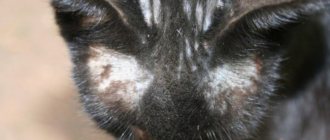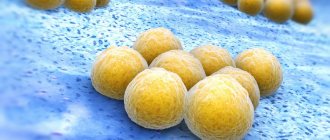General information
Felinosis is an infectious disease better known as cat scratch fever.
It is very easy to catch it through contact with a member of the cat family, a carrier of protobacteria of the genus Bartonella (Bartonella henselae), if the animal scratches or bites you. The pathogens are similar to rickettsia, have one flagellum, are capable of intracellular parasitism, and reproduce by simple transverse division. The main manifestation of zoonosis is local inflammation of the lymph nodes, as well as fever , chills and general intoxication .
Bartonella henselae
The disease was first described in 1932 by R. Debreu and C. Foshay and became known as benign lymphoreticulosis . Subsequently, the pathology that develops after scratching cats was studied in detail by French scientists and was named Mollaret granuloma . The specific name of the pathogen, “henselae,” was given in honor of D. Hensel, a technologist at the Oklahoma Health Sciences Center, who collected numerous strains and samples of the infectious agent during an outbreak of felinosis in Oklahoma in 1985.
Treatment
For the treatment of uncomplicated felinosis, erythromycin 500 mg 4 times a day, doxycycline 100 mg 2 times a day or ciprofloxacin 500 mg 2 times a day are used. The course of treatment is 10-14 days. Alternative drugs are tetracyclines, azithromycin, chloramphenicol, ofloxacin in medium therapeutic doses. The effectiveness of these drugs is not always evident. Symptomatic medications, vitamins, and antihistamines are prescribed. Nonsteroidal anti-inflammatory drugs (indomethacin, voltaren, etc.) are indicated. When a lymph node softens, an incision or puncture is made to remove pus.
Pathogenesis
Infection with felinosis occurs during licking, animal bites or through damaged skin, for example, cat scratches or pre-existing injuries - microcracks, cuts, etc. In 50% of cases, nodular rashes - papules - form at the site of damage, which subsequently rot. Along the lymphogenous route, the infection disseminates to the lymph nodes, causing regional lymphoreticulosis , accompanied by the formation of an inflammatory infiltrate and reticulocyte hyperplasia. As a result, granulomas of epithelioid cells are formed, similar to brucellosis and stellate abscesses, which in the process undergo necrotization and can transform into fistulas .
The acute inflammatory process can regress and lead to sclerosis of the lymph nodes. If the lymphatic barrier is overcome, then Bartonella can spread through the hematogenous route and penetrate into various organs, and form similar granulomas .
Intoxication of the body occurs due to the release of toxins by bacteria and the accumulation of tissue breakdown products, which in addition can also cause allergic reactions .
Classification
According to the clinical picture and course, cat scratch disease is:
- The typical form is primary affect with lymphadenitis .
- An atypical form, for example, ocular (when infected animal saliva gets on the conjunctiva) or accompanied by damage to the central nervous system, liver and other organs.
- In patients with AIDS , due to its affinity for vascular endothelial cells, Bartonella henselae can cause hyperplastic processes with the formation of hemangiomas , reminiscent of Kaposi's sarcoma .
Manifestations of the disease
Typically, cat scratch disease excludes the manifestation of symptoms in pets, but there are rare cases when something appears in a furry cat, for example: fever, enlarged lymph nodes, muscle pain, etc.
Symptoms in people signal themselves differently. After Bartonella gets into the right environment, it begins to multiply. It may take 2-3 weeks for the disease to manifest itself through external signs or internal changes. Mostly, after 6-14 days, in the area where the cat scratched with a claw, a rash appears in the form of several pimples (papules), which do not cause discomfort.
After 2-3 days, pus forms in these pimples, which then comes out, and the entire rash begins to dry out. This indicates that the bacteria has multiplied sufficiently and has entered the lymph nodes.
About 10 days after the rash appears, the person who has been bitten or scratched will notice that their lymph nodes have become significantly larger in some areas. For example, if the skin of the arm below the elbow is damaged, the axillary lymph nodes enlarge (up to 5-10 cm), elbow and cervical (all at once or one group). When you feel them, pain occurs.
Other symptoms:
- migraine;
- high temperature (sometimes 39 degrees and above);
- weakness and insomnia;
- profuse sweating;
- poor appetite.
It is interesting that some infected people do not feel the manifestations of the disease at all, or they have them in an insignificant form, so that the person does not perceive this as a problem at all.
Causes
Cats, as natural reservoirs of lymphoreticulosis, themselves remain healthy, the pathogen invades the normal microflora of the animal’s saliva, and the fleas Ctenocephalides felis take part in the circulation between cats.
There are known cases where cat scratch syndrome developed during contact with monkeys, dogs, guinea pigs and other rodents. Bartonella henselae infection can be found in saliva, on nails and paws, and in urine.
It affects mainly children and adolescents, who often tease and play with animals, as well as people with immunodeficiencies .
The disease is characterized by seasonality - outbreaks more often occur in the autumn-winter period, pathogens are ubiquitous. There are no known cases of person-to-person transmission.
Symptoms of cat scratch disease
The first symptoms of felinosis may appear 3-10, or even 45 days after infection. At the first stage, reddish papules form at the site of the wound (primary bartonellosis). During the height of bertonellosis, papular rashes begin to turn into vesicles and begin to rot, ulcers form, and then hyperpigmented crusts, which are rejected without scarring.
As a result of the penetration of Bartonella along the lymph flow paths, at the next stage regional lymphadenopathy - most often one or more lymph nodes are enlarged, usually axillary, subcervical, less often - inguinal, submandibular. They reach significant sizes, become dense, inactive and, when palpated, cause mild painful sensations.
Submandibular lymphadenitis
At the recovery stage, there is a disappearance of signs of intoxication, gradual resorption, sclerosis or suppuration of the lymph nodes, which can lead to their subsequent opening. Healing is long - it can take more than 3 months. The transferred disease results in lasting immunity , but there have also been cases of relapse.
Symptoms of general intoxication of cat scratch disease include fever for 1-3 weeks, as well as:
- malaise;
- headache;
- myalgia;
- loss of appetite;
- allergic skin rash;
- enlarged liver and spleen.
Symptoms of atypical form of cat scratch fever
Atypical signs of felinosis are:
- unilateral conjunctivitis , accompanied by the formation of ulcers and papules;
- angina;
- atypical pneumonia;
- myocardial damage;
- abdominal pain;
- unilateral neuroretinitis , expressed in the form of swelling of the optic nerve head, angiomatous changes, formation of nodules and star spots on the retina;
- granulomatous changes in the liver and hepatic purpura .
Disease, cat scratch syndrome: treatment with folk remedies
Important: Folk remedies can be used in the treatment of felinosis only if the disease is mild. Treatment of a disease with complications should be carried out by a highly qualified doctor.
Folk remedies help relieve inflammation, alleviate the general condition of the body, and heal wounds.
The juice of fresh plants has disinfecting and regenerating properties:
- Celandine
- Calendula flowers
- Yarrow
- Nettles
Please note that for a good effect, only fresh juice is needed. If you can find the juice from these plants, good. Obtaining fresh plant juice is not easy for known reasons.
If there is no juice, you will have to look for other methods of treating cat scratch disease. First emergency aid you can provide for a bite or scratch:
- Wash the wound with regular laundry soap .
- Wash the wound with alcohol or regular cologne, pour brilliant green.
First aid for a scratch
The affected areas can be wiped with an infusion of dried chamomile flowers , which are sold in pharmacies.
At the same time, with felinosis, it is desirable to increase immunity. For this, a folk remedy such as echinacea tincture .
As you can see, having fun with our little brothers can turn into a completely unpleasant situation. There is no specific prevention for this disease. The only thing that can be advised is not to touch unfamiliar street cats, and also to warn children against playing with them. If you are bitten or scratched by your pet, treat the wound with an antiseptic and monitor the condition of the body over the next month. If symptoms of felinosis appear, seek help at the hospital.
Tests and diagnostics
Bartonella are gram-negative polymorphic bacteria that can grow on a variety of nutrient media, so they are cultured in blood culture with lysis-centrifugation and detected using silver staining or Warthin-Starry.
During laboratory tests, blood tests reveal:
- eosinophilia;
- increased ESR.
In addition, anamnesis data is studied: history of contact with animals, symptoms, the presence of papules at the site of infection, inflamed lymph nodes.
Diagnosis and treatment of felinosis becomes more complicated in the absence of a gateway of infection; in less than 10% of people, the disease manifests itself only in systemic reactions.
Histological studies of biopsy samples, skin allergy tests, enzyme-linked immunosorbent assay using antiserum and PCR are considered indicative.
Diagnostics
The diagnosis in typical cases of the disease is established on the basis of clinical and epidemiological data (contact with cats, traces of their scratches, the presence of primary affect, lymphadenitis). Laboratory diagnosis can be confirmed by PCR and ELISA, histological examination of biopsy specimens and microbiological examination of discharged suppurating lymph nodes, punctate lymph nodes, and blood.
Differential diagnosis is carried out with acute bacterial lymphadenitis, cutaneous bubonic form of tularemia, tuberculosis of the lymph nodes, and lymphomas. In HIV infection, the differential diagnosis of bacillary angiomatosis and Kaposi's sarcoma presents great difficulties.
Diet for lymphadenitis
Diet 15 table
- Efficacy: therapeutic effect after 2 weeks
- Timing: constantly
- Cost of food: 1600-1800 rubles per week
Table No. 15 is best suited - nutrition that does not require a therapeutic approach when creating a diet. At the same time, it is necessary to limit the consumption of fatty, spicy, salty and fried foods, and give up sweets and street food.
The diet should contain sufficient amounts of dairy products, seafood, vegetables and mushrooms, plant and animal protein.










